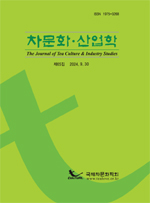송대는 문학과 예술이 번영한 시기로, 차문화는 단순한 기호품의 소비를 넘어 심미적·철학적·실용적 요소가 결합된 복합적인 문화 현상으로 발전하였다. 경제적 번영과 과거제도의 확대는 문인 사대부 계층의 성장을 촉진하며 차문화의 미학적 성격을 강화하였고, 차마무역의 활성화는 차의 실용적 가치를 부각시켰다. 문인들은 차를 심신의 조화와 청렴한 내면을 추구하는 행위로 인식하며, 차문화를 시, 산문, 다구, 다서 등을 통해 문학과 예술적 논의로 확장시켰다. 반면, 서민층에서는 차가 일상의 필수품이자 오락과 소비 중심의 문화로 발전하며 대중화되었다. 이러한 과정에서 송대 차문화는 고상함(雅)과 실용성(俗)을 조화롭게 포용하는 아속겸비(雅俗兼備)의 독특한 성격을 형성하였다. 『대관다론』을 비롯한 문헌에서는 차의 품질과 음다 방식을 체계화하였으며, 『동경몽화록』과 『몽견록』등은 서민층의 차 소비 문화를 반영하고 있다. 본 연구는 송대 차문화가 문인과 서민층 간의 문화적 융합을 이루는 매개체로 작용했음을 조명하며, 이를 통해 송대 차문화의 특성을 보다 깊이 이해하는 데 기여하고자 한다.
The Song Dynasty was a period of flourishing literature and arts, during which tea culture evolved into a complex cultural phenomenon that encompassed aesthetic, philosophical, and practical elements beyond mere consumption. Economic prosperity and the expansion of the imperial examination system fostered the growth of the literati class, reinforcing the aesthetic aspects of tea culture, while the revitalization of tea trade emphasized its utilitarian value. The literati perceived tea as a means of cultivating inner purity and harmony, integrating it into poetry, prose, teaware, and tea books, thereby expanding tea culture into a subject of literary and artistic discourse. In contrast, for the common people, tea became an essential part of daily life, a form of entertainment, and a symbol of mass consumption. This process led to the formation of a unique tea culture that embodied the harmonization of elegance (雅) and vulgarity (俗), known as 雅俗兼備 (Yasokgyeombi). Literary works such as Treatise on Tea of the Grand View Era (『大觀茶論』) systematically documented tea quality and brewing methods, while records such as Dreams of the Eastern Capital (『東京夢華錄』) and Dreams and Visions (『夢見錄』) reflected the tea consumption culture of the common people. This study highlights how Song Dynasty tea culture functioned as a cultural bridge between different social classes, contributing to a deeper understanding of the distinctive characteristics of Song tea culture.
Ⅰ. 서론
Ⅱ. 문인 계층의 아취 차문화
Ⅲ. 서민 계층의 통속적 차문화
Ⅳ. 아속겸비적 차문화
Ⅴ. 결론
(0)
(0)
